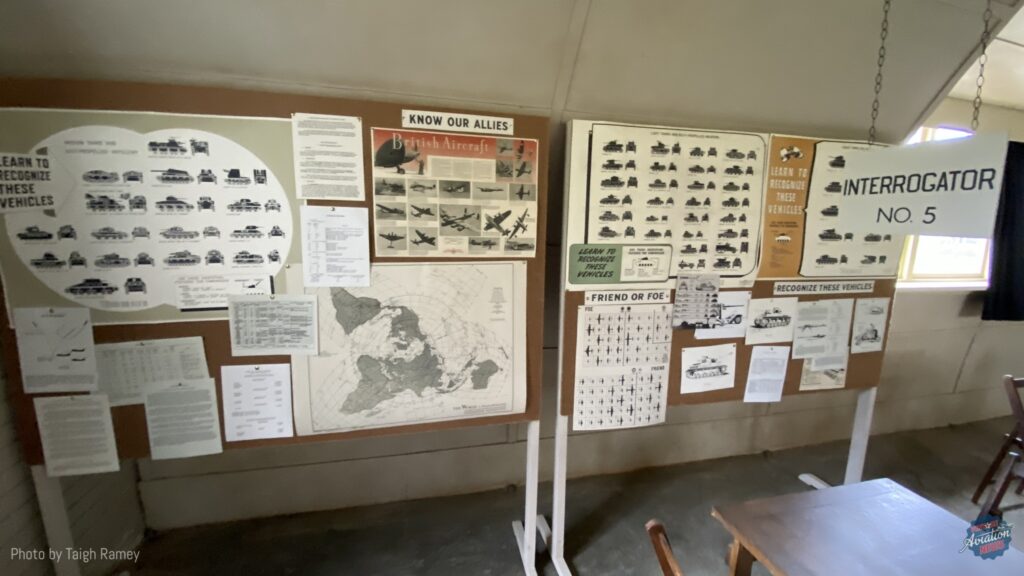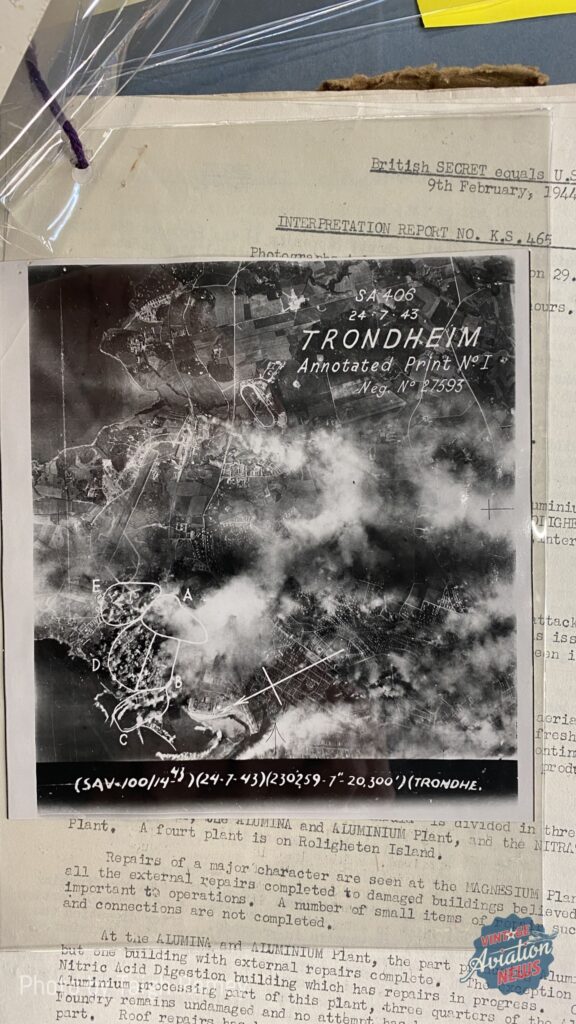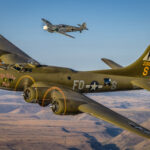By Taigh Ramey.
Once again, thanks to well-known warbird expert Taigh Ramey, we can take you behind the scenes with the current Apple TV+ Masters of the Air series. Here Taigh gives us this insight into an area that would be easy to underestimate in importance – the maps and paperwork recreated for the series. Technically, these kind of elements on film and TV are known as ‘Hero Props‘ when they are handled by main characters, or illustrate a key element of the story. Over to Taigh:
I had the pleasure of working with the graphics department on many topics from navigation to mission planning, forms, manuals, research, and just plain answering questions. Dan Burke was the department head but I mostly worked with Megan Jones and her wonderful pup Indy.
When on set, like in one of the offices that you have seen in the first two episodes or anywhere else in the series, you will see bulletin boards, clip boards, file folders and in and out trays and typewriters filled with paperwork. If you were able to pick up one of these documents you will find actual 100th BG documents faithfully recreated and they are also pertinent to the specific time of the scene. And I am not just talking a page on top but all the way through the stack!
The mission orders came in to the bomb groups via teletype machines and were printed out on special sized roll paper. Meg found a guy who had working WWII teletypes and then she found the exact paper. She printed up the correct mission reports and they were coming out of the machines and looked great!
One of the things that Meg asked me about was the navigation paperwork. Crosby had several scenes where he was navigating and just what kind of paperwork would he have had?
Charts, maps and navigators logs was the answer to begin with. I had brought examples of those with me to teach the actors how to look like they could navigate. I even had some of my Dad’s paperwork and nav kit along. Meg recreated his bare nav log to use with Crosby’s scenes.
We then looked in to the mission routes so we could fill out the nav logs and mark the charts and big briefing wall map accurately. I dove in to the archives mission files that they had procured from sources in the US but since this was deep in the middle of COVID the archives were closed down and getting additional research information was problematic. The National Archives in the UK opened up and I was there on the weekend doing research. Instead of the multi generation degraded copies that production received from the US these files were all original and in perfect condition. Incredible stuff for sure with all of the photos complete with Air Ministry water marks on the back of the paper.
In the mission files were the planned route of the mission and also the actual route flown which were often quite different. I dug in to the files and was able to plot out the planned and actual mission routes on charts that Meg had reproduced. For the pilot types reading this I also plotted all of the routes on ForeFlight to help with quick calculations for the headings as we actually put in the winds that were encountered and reported in the mission file. Meg ended up getting ForeFlight so we could share the plots and work out the future missions.
One of the things that I hadn’t realized but was revealed in the reports was just how much time was spent in forming up the whole attacking armada. Each bomb group would all take off and form up over their own air field. Then they would go to specific assembly areas and form up the wings and full task force. It took two, three or more hours of flying just to do this over the UK before they headed toward fortress Europe. Amazing really and it explains why so many aircrew died during this from collisions climbing through the ugly weather. Hundreds and then thousands of aircraft all coming up through the heavy cloud layer on instruments trying not to hit each other. A lot of them did and a near miss sequence is depicted in the series.
So when you see the paperwork, posters, maps, teletypes and amazing other details you can appreciate the efforts of Megan and the graphics department. And all of the other departments, some of which I will try to highlight in future posts.
Taigh prefixes his insights with this introduction, well worth noting:
So many people, from so many different departments, busted their backsides to get things right. Some folks went so far beyond their job description to to search out what was correct and make it so. I will try to share some of these efforts and the people behind it as best as I can. Please understand that for every one person or detail that I may mention that there are hundreds, if not thousands of others, who are the unsung heroes of this production and many others.
Vintage Aviation News would like to thank Taigh Ramey for being able to see ‘behind the scenes’ of Masters of the Air. We have more to share from Taigh, but you can also experience his expertise ‘hands-on’ at this year’s Bomber Camp™, details are below:
Would you like to get a LOT closer to experiencing flying your mission in a legendary B-17 Flying Fortress? Young or old, you can live your dream at Bomber Camp™! Bomber Camp™ was devised by this article’s author, Taigh Ramey, the founder of the Stockton Field Aviation Museum and avid WWII collector and history buff. Bomber Camp™ is much more than a “fantasy camp”. It is an immersive WWII living history experience allowing you to step back in time to train for a bombing mission and then to fly it, for real. You can shoot the guns, ride in the ball turret, and drop a bomb with the famous Norden bombsight. This once-in-a-lifetime opportunity can be yours. Enlist now! www.bombercamp.org.
Read James Kightly’s first article of this series.
https://vintageaviationnews.com/warbirds-news/master-of-the-b-17-cockpit-dave-littleton.html

























![Hollywood Premiere for 'Masters of the Air', Exclusive Review 11 Tom Hanks with WWII veterans of the 100th Bomb Group. [Photo by Nicholas Kanakis]](https://vintageaviationnews.com/wp-content/uploads/image5-2-150x150.jpeg)


![Sea Fury Sawbones Sold to Australia 25 Sea Fury VH-HPB, formerly the Reno racer Sawbones, is unpacked in Australia after purchase by Paul Bennet. [Photo Paul Bennet Airshows via Facebook]](https://vintageaviationnews.com/wp-content/uploads/VH-HFB-202302xx-Paul-Bennet-Airshows-via-Facebook-01-150x150.jpg)













